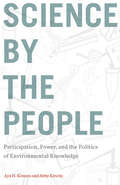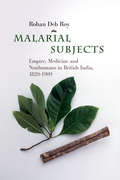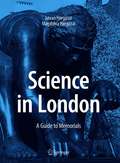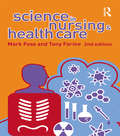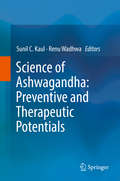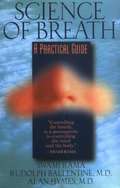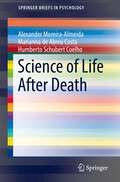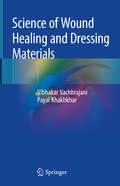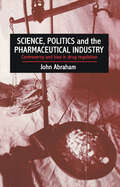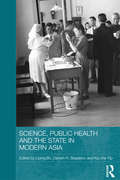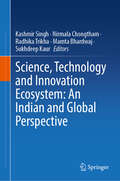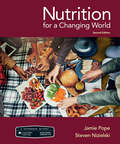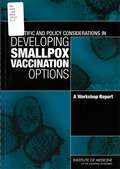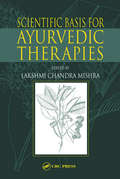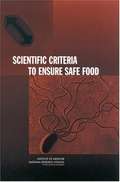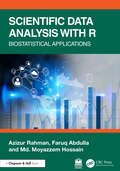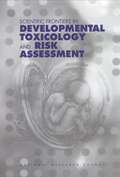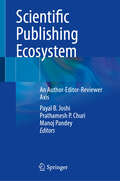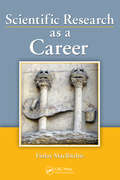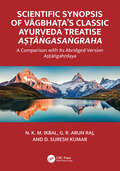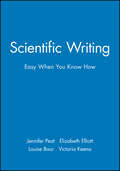- Table View
- List View
Science between Europe and Asia
by Feza Günergun Dhruv RainaThis book explores the various historical and cultural aspects of scientific, medical and technical exchanges that occurred between central Europe and Asia. A number of papers investigate the printing, gunpowder, guncasting, shipbuilding, metallurgical and drilling technologies while others deal with mapping techniques, the adoption of written calculation and mechanical clocks as well as the use of medical techniques such as pulse taking and electrotherapy. While human mobility played a significant role in the exchange of knowledge, translating European books into local languages helped the introduction of new knowledge in mathematical, physical and natural sciences from central Europe to its periphery and to the Middle East and Asian cultures. The book argues that the process of transmission of knowledge whether theoretical or practical was not a simple and one-way process from the donor to the receiver as it is often admitted, but a multi-dimensional and complex cultural process of selection and transformation where ancient scientific and local traditions and elements. The book explores the issue from a different geopolitical perspective, namely not focusing on a singular recipient and several points of distribution, namely the metropolitan centres of science, medicine, and technology, but on regions that are both recipients and distributors and provides new perspectives based on newly investigated material for historical studies on the cross scientific exchanges between different parts of the world.
Science by the People: Participation, Power, and the Politics of Environmental Knowledge (Nature, Society, and Culture)
by Aya H. Kimura Abby KinchyCitizen science—research involving nonprofessionals in the research process—has attracted both strong enthusiasts and detractors. Many environmental professionals, activists, and scholars consider citizen science part of their toolkit for addressing environmental challenges. Critics, however, contend that it represents a corporate takeover of scientific priorities. In this timely book, two sociologists move beyond this binary debate by analyzing the tensions and dilemmas that citizen science projects commonly face. Key lessons are drawn from case studies where citizen scientists have investigated the impact of shale oil and gas, nuclear power, and genetically engineered crops. These studies show that diverse citizen science projects face shared dilemmas relating to austerity pressures, presumed boundaries between science and activism, and difficulties moving between scales of environmental problems. By unpacking the politics of citizen science, this book aims to help people negotiate a complex political landscape and choose paths moving toward social change and environmental sustainability.
Science in History: Empire, Medicine and Nonhumans in British India, 1820–1909 (Science in History)
by Roy Rohan DebMalaria was considered one of the most widespread disease-causing entities in the nineteenth century. It was associated with a variety of frailties far beyond fevers, ranging from idiocy to impotence. And yet, it was not a self-contained category. The reconsolidation of malaria as a diagnostic category during this period happened within a wider context in which cinchona plants and their most valuable extract, quinine, were reinforced as objects of natural knowledge and social control. In India, the exigencies and apparatuses of British imperial rule occasioned the close interactions between these histories. In the process, British imperial rule became entangled with a network of nonhumans that included, apart from cinchona plants and the drug quinine, a range of objects described as malarial, as well as mosquitoes. Malarial Subjects explores this history of the co-constitution of a cure and disease, of British colonial rule and nonhumans, and of science, medicine and empire. This title is also available as Open Access.
Science in History: Toxic Histories
by David ArnoldToxic Histories combines social, scientific, medical and environmental history to demonstrate the critical importance of poison and pollution to colonial governance, scientific authority and public anxiety in India between the 1830s and 1950s. Against the background of India's 'poison culture' and periodic 'poison panics', David Arnold considers why many familiar substances came to be regarded under colonialism as dangerous poisons. As well as the criminal uses of poison, Toxic Histories shows how European and Indian scientists were instrumental in creating a distinctive system of forensic toxicology and medical jurisprudence designed for Indian needs and conditions, and how local, as well as universal, poison knowledge could serve constructive scientific and medical purposes. Arnold reflects on how the 'fear of a poisoned world' spilt over into concerns about contamination and pollution, giving ideas of toxicity a wider social and political significance that has continued into India's postcolonial era.
Science in London: A Guide to Memorials
by Istvan Hargittai Magdolna HargittaiThis book introduces the reader to the statues, busts, and memorial plaques of scientists, explorers, medicine men and women, and inventors found in the bustling capital of the United Kingdom, London. The former capital of the British Empire, London remains a world center of trade, navigation, finance and many more. It is also a hub of science, the seat of the Royal Society, Royal Institution, Science Museum, British Museum, Natural History Museum, and of great institutions of higher education. The historical figures depicted in these memorials are responsible for creating great institutions, milestone discoveries, contributions to the scientific and technological revolutions, fighting against epidemics, advancing medicine, and contributing to the progress seen during the past four hundred years. This is a guidebook for the visitor and the Londoner alike. It presents memorials that everybody is familiar with and others that the authors discovered during their years of painstaking research. The 750 images and the text, interlarded with anecdotes, is both informative and entertaining.
Science in Nursing and Health Care
by Tony Farine Mark A. FossThe basic scientific principles underlying health care become clear with this straightforward, engaging and applied book.The authors of Science in Nursing and Health believe that in order to provide the best patient care, it's necessary to understand the diverse areas of science that inform it. Written in a question and answer format, this book will show you how science concepts relate to nursing and health care. It's packed with applications and real-life examples that show how relevant a good understanding of science is to your everyday practice.
Science of Ashwagandha: Preventive and Therapeutic Potentials
by Renu Wadhwa Sunil C. KaulRapidly increasing aging population and environmental stressors are the two main global concerns of increasing incidence of a variety of pathologies in the modern society. The complex etiologies and pathologies cause major challenges to disease treatment. On the other hand, several herbs are known for their health-caring and disease-curing activities. Ashwagandha, a popular herb in Indian traditional home medicine, Ayurveda, has gathered increasing recognition in recent years when the chemically synthesized drugs for single target therapies showed limited success and adverse toxic effects. Ashwagandha is known as a powerful adaptogen and trusted to enhance function of the brain, reproductive system, cell-mediated immunity and increase the body's defense against disease, and possess anti-inflammatory, anticancer and anti-arthritic activities. In this book, for the first time, we provide a complete portrait on scientific understanding of the effects of Ashwagandha and its active principles for a variety of preventive and therapeutic activities.
Science of Breath: A Practical Guide
by Swami Rama Rudolph Ballentine Alan HymesMuch of the Western world was completely unaware of the profound impact of the breath on the body and mind until the 1970's. It was during this time that Swami Rama astonished physiologists by demonstrating perfect control over his heart rate and brain waves―something Western scientists didn't believe humans could possibly achieve. In this book, Swami Rama shares some of the basic breathing techniques practiced by Himalayan yogis, so that you too can experience the profound effects of pranayama and breath control. <p><p> The goal of Science of Breath is to present knowledge and practices regarding the breath in a way that can be applied to personal growth. This book is a masterful guide to systematically identifying bad breathing habits, replacing those habits with healthy breathing patterns, and developing control over pranic flow. Learn how to develop and master the link between your body and mind through the understanding of the breath. With increased awareness and control of the subtle aspects of breathing, one can effect deep physical and psychological changes and begin to master the roaming tendencies of the mind. Science of Breath opens the door to a new way of being, providing a powerful tool in the pursuit of holistic health and personal growth.
Science of Life After Death (SpringerBriefs in Psychology)
by Alexander Moreira-Almeida Marianna de Costa Humberto Schubert CoelhoThis book examines the best available empirical evidence regarding one of the most challenging and pervasive questions throughout ages, cultures, and religions: the survival of human consciousness after death. It begins with a contextual overview of belief in personal survival and refutes misguided historical and epistemological arguments against the notion of survival after death (e.g., irrational, purely religious, impossible to be addressed by science, that has been proved false by neuroscience). The book provides an overview of the scientific evidence regarding the survival of human consciousness after death, focusing on studies on mediumship, near-death and out-of-body experiences, and reincarnation.Featured topics of coverage include:The belief in life after death in the contemporary world as well as in the history of religions and philosophy.The key misguided arguments and prejudices against the academic study of afterlife survival.What constitutes empirical evidence for survival after death?The main explanatory hypotheses alternative to survival after death.The chief cultural barriers to a fair examination of the available evidence for survival of consciousness after death. Science of Life After Death is an essential resource for researchers, professors, and graduate students as well as clinicians, therapists, and other professionals in developmental and clinical psychology; spirituality, religious. and consciousness studies; psychiatry; neuroscience / neurology; phenomenology / philosophy; complementary and alternative medicine; and all interrelated disciplines.
Science of Wound Healing and Dressing Materials
by Vibhakar Vachhrajani Payal KhakhkharThis book outlines, from a surgeon’s standpoint, how physicians and mid-level providers working at wound care centres can expeditiously and effectively manage wounds. It comprehensively addresses the concept of wound healing, from the healing process to debridement concepts, and various antiseptics and local antibiotics used in dressing materials to facilitate healing. The book also discusses the latest inventions and treatment options that have revolutionized wound healing, such as: oxygen therapy, ozone therapy, hyperbaric oxygen therapy, electric therapy and ultrasonic wound therapy. In closing, it examines the latest regenerative therapies based on stem cell therapy, cellular therapy and gene therapy. Given its scope, the book offers a valuable resource for medical students and physicians dealing with wound management, as well as a reference guide for nurses in primary and tertiary wound care settings.
Science, Politics And The Pharmaceutical Industry: Controversy And Bias In Drug Regulation
by John Abraham 0 John Abraham University of Reading.,Drug disasters from Thalidomide to Opren, and other less dramatic cases of drug injury, raise questions about whether the testing and control of medicines provides satisfactory protection for the public. In this revealing study, John Abrahan develops a theoretically challenging realist approach, in order to probe deeply into the work of scientists in the pharmaceutical industry and governmental drug regulatory authorities on both sides of the Atlantic. Through the examination of contemporary controversial case studies, he exposes how the commercial interest of drug manufacturers are consistently given the benefit of the scientific doubts about medicine safety and effectiveness, over and above the best interests of patients.; A highly original combination of philosophical rigour, historical sensitivity and empirical depth enables the "black box" of industrial and government science to be opened up to critical scrutiny much more than in previous social scientific study. All major aspects of drug testing and regulation are considered, including pre- clinical animal tests, clinical trials and postmarketing surveillance of adverse drug reactions. The author argues that drug regulators are too dependent on pharmaceutical industry resources and expertise, and too divorced from public accountability. The problem of corporate bias is particularly severe in the UK, where regulatory decisions about medicine safety are shrouded in greater secrecy than in the US.; Since the purpose of drug regulation should be to maximize the safety and effectiveness of medicines for patients, the public needs and deserves policies to counteract corporate bias in drug testing and evaluation. John Abraham's realist analysis provides a robust basis for policy interventions at the institutional and legislative levels. He proposes that corporate bias could be reduced by more extensive freedom of information, greater autonomy of government scientists from pharmaceutical industry, the development of independent drug testing by the regulatory authority, increased patient representation on regulatory committees, and more frequent and thorough oversight of regulatory performance by the legislature. This book should be of interest to anyone who cares about how medicines should be controlled in modern society. It should prove particularly rewarding for students and researchers in the sociology of science and technology, science and medicines policy, medical sociologists, the medical and pharmaceutical professions, and consumer organizations.
Science, Public Health and the State in Modern Asia (Routledge Studies in the Modern History of Asia)
by Liping Bu Ka-Che Yip Darwin H. StapletonThis book examines the encounter between western and Asian models of public health and medicine in a range of East and Southeast Asian countries over the course of the twentieth century until now. It discusses the transfer of scientific knowledge of medicine and public health approaches from Europe and the United States to several Asian countries — Singapore, Hong Kong, Indonesia, Sri Lanka, Japan, Taiwan, and China — and local interactions with, and transformations of, these public health models and approaches from the nineteenth century to the 1950s. Taking a critical look at assumptions about the objectiveness of science, the book highlights the use of scientific knowledge for political control, cultural manipulation, social transformation and economic needs. It rigorously and systematically investigates the historical developments of public health concepts, policies, institutions, and how these practices changed from colonial, to post-colonial and into the present day.
Science, Technology and Innovation Ecosystem: An Indian and Global Perspective
by Nirmala Chongtham Kashmir Singh Radhika Trikha Mamta Bhardwaj Sukhdeep KaurScience, Technology, and Innovation (STI) are the key drivers of the economy and development of a country. The economic and social impacts of STI require a deep understanding of the STI ecosystem, which includes the interactions between actors, their technologies, and their business models. This book, "Science, Technology, and Innovation Ecosystems: A National and Global Perspective," focuses on the STI ecosystem of India in comparison to other innovation-backed global countries. It will include a study of the entire STI ecosystem, focusing on the system interconnectedness required for strengthening it. The building of interconnection within actors of the STI ecosystem is one of the paramount requirements to reinvigorate the STI ecosystem as a whole. The book will also present the crucial role of STI in bringing socio-economic development from a national and international perspective. It addresses the development of viable solutions for a sustainable future and a positive societal transformation with the help of innovative science-based approaches. This book showcases the future of science in terms of emerging frontier and strategic technologies, giving us a snapshot of future STI efforts worldwide. Emphasis is given to the policy directives and program interventions backed by evidence to revamp the STI system by addressing the societal and economic needs of the country. The book will strategically bring the concept of the relevance of the Intellectual Property (IP) ecosystem in building the country’s innovation capacity along with specific pieces of evidence on how the IP system should be roped in to bring higher innovation efficiency. An insight is provided to chart out the pathway for creating a knowledge-based economy focusing on knowledge production to knowledge consumption through knowledge diffusion.
Scientific American: Nutrition for a Changing World
by Jamie Pope Steve NizielskiNutrition for a Changing World engages students like no other nutrition textbook. Real stories – about real people and real science – are integrated into every chapter, bringing context and relevance to the core science. Infographics in the style of Scientific American magazine are like “science storyboards” that guide students step-by-step through essential processes and concepts. Coverage of timely topics such as gluten-free diets, the diabetes epidemic, and global nutrition exemplify the book’s contemporary approach to nutrition science. Nutrition for Changing World is also the only product for the course to offer automatically graded diet analysis activities. AnalyzeMyDiet provides both a diet tracker and personalized, auto-graded diet analysis activities built to cover a standard 3- to 7-day diet analysis assignment, freeing instructors from hand-grading these projects.
Scientific And Policyconsiderations In Developingsmallpox Vaccination Options: A Workshop Report
by Disease Prevention Board on Health PromotionA report on Scientific And Policyconsiderations In Developingsmallpox Vaccination Options
Scientific Basis for Ayurvedic Therapies
by Lakshmi Chandra MishraArguably the oldest form of health care, Ayurveda is often referred to as the "Mother of All Healing." Although there has been considerable scientific research done in this area during the last 50 years, the results of that research have not been adequately disseminated. Meeting the need for an authoritative, evidence-based reference, Scientific Ba
Scientific Criteria to Ensure Safe Food
by National Research CouncilFood safety regulators face a daunting task: crafting food safety performance standards and systems that continue in the tradition of using the best available science to protect the health of the American public, while working within an increasingly antiquated and fragmented regulatory framework. Current food safety standards have been set over a period of years and under diverse circumstances, based on a host of scientific, legal, and practical constraints. Scientific Criteria to Ensure Safe Food lays the groundwork for creating new regulations that are consistent, reliable, and ensure the best protection for the health of American consumers. This book addresses the biggest concerns in food safety—including microbial disease surveillance plans, tools for establishing food safety criteria, and issues specific to meat, dairy, poultry, seafood, and produce. It provides a candid analysis of the problems with the current system, and outlines the major components of the task at hand: creating workable, streamlined food safety standards and practices.
Scientific Data Analysis with R: Biostatistical Applications
by Azizur Rahman Faruq Abdulla Md. Moyazzem HossainIn an era marked by exponential growth in data generation and an unprecedented convergence of technology and healthcare, the intersection of biostatistics and data science has become a pivotal domain. This book is the ideal companion in navigating the convergence of statistical methodologies and data science techniques with diverse applications implemented in the open-source environment of R. It is designed to be a comprehensive guide, marrying the principles of biostatistics with the practical implementation of statistics and data science in R, thereby empowering learners, researchers, and practitioners with the tools necessary to extract meaningful knowledge from biological, health, and medical datasets.This book is intended for students, researchers, and professionals eager to harness the combined power of biostatistics, data science, and the R programming language while gathering vital statistical knowledge needed for cutting-edge scientists in all fields. It is useful for those seeking to understand the basics of data science and statistical analysis, or looking to enhance their skills in handling any simple or complex data including biological, health, medical, and industry data.Key Features: Presents contemporary concepts of data science and biostatistics with real-life data analysis examples Promotes the evolution of fundamental and advanced methods applying to real-life problem-solving cases Explores computational statistical data science techniques from initial conception to recent developments of biostatistics Provides all R codes and real-world datasets to practice and competently apply into reader’s own domains Written in an exclusive state-of-the-art deductive approach without any theoretical hitches to support all contemporary readers
Scientific Explorations of Adhatoda vasica: An Asian Health Remedy (SpringerBriefs in Plant Science)
by Khalid Rehman Hakeem M. AliNatural remedies play an important role in curing ailments that happen by chance or adoptively. Adhatoda vasica is a natural Asian remedy that has the potential to treat respiratory disorders, among others. While existing literature does exist on this medicinal plant, it can be cumbersome to sort through for information relevant to academics, research, and practice. This work reframes and consolidates information on Adhatoda vasica so that it is easier to approach through academic, research, and practitioner perspectives.
Scientific Frontiers In Developmental Toxicology And Risk Assessment
by Committee on Developmental ToxicologyThe report, a consensus of committee members, evaluates current approaches to assessing risk for developmental defects, identifies key areas of uncertainty in those approaches, evaluates the current understanding of the mechanisms of action of chemicals that result in developmental defects, and explore how new scientific information can be used to improve risk assessment for developmental toxicants and to elucidate the mechanisms by which toxicants induce developmental defects. Annotation c. Book News, Inc. , Portland, OR (booknews. com)
Scientific Publishing Ecosystem: An Author-Editor-Reviewer Axis
by Manoj Pandey Prathamesh P. Churi Payal B. JoshiThe book aims to converge the perspectives of authors, editors, and reviewers to discuss modern scientific publishing practice and emerging concerns in the contemporary world. Authors, editors, and reviewers form a triage in a publishing ecosystem which is witnessing a huge pressure due to changing evaluation criteria for career progression and grant funding. The major perspective of this book is to put forth the present-day emerging ills of modern publishing system and sensitize the research fraternity - be it young researchers or established scientists towards practicing good science and preserving spirit of scientific discoveries. The edited book consists of three parts viz, Part I “Authors, Authorship, and Scholarly Dissemination” features ten chapters devoted to describe authorship issues and good publication practice, plagiarism concerns, preprints, open access models, conflicting interests, rise of review papers, writing book reviews, and assessing faculty beyond metrics. Part II “Editors, Editorial Desks, and Issues of Scientific Misconduct” features eight chapters devoted to discuss on issues of editorial misconduct, desk rejections, paper mills, letters to editors, image duplication, emerging ChatGPT in writing/reviewing spaces, citation cartels, and retractions. Finally, Part III “Reviewers and Developing Evaluator’s Eye” features five chapters devoted to discuss peer review as an idea creating model, paying peer reviewers, training reviewers, peer review manipulations, and peer review in age of AI . All chapters in the book are written by expert contributors of the field that provides a systematic approach of understanding various challenges, opportunities, and ethical considerations of scientific publishing ecosystem. Most of the chapters have featured recent cases of scientific misconduct as examples to reflect scale of the problem. This book will serve as a reference to research practitioners in understanding assigning authorship on papers, modern-day publishing collaboration, role of editors to serve journals in a holistic manner and ensuring fair peer review mechanisms.
Scientific Research as a Career
by Finlay MacRitchieDescribing the philosophy of the scientific method and the training and professional characteristics needed for a successful career, Scientific Research as a Career is a comprehensive "how-to" guide for the aspiring scientist. Based on the author's experience both as a scientist in a research organization and as a university mentor, the book covers
Scientific Standards for Studies on Modified Risk Tobacco Products
by Institute of Medicine of the National AcademiesSmoking is the leading cause of preventable morbidity and mortality in the United States, contributing to approximately 443,000 premature deaths each year nationally (CDC, 2008). Smoking-related disease causes more deaths than alcohol, illicit drug use, homicide, and suicide combined (Mokdad et al., 2004). Another 8.6 million smokers in the United States live with a smoking-attributable illness (CDC, 2009a). In total, tobacco-related mortality amounts to approximately 5.1 million years of potential life lost per year (CDC, 2008). Smoking also imposes enormous costs on the U.S. health care system and economy, with an estimated $193 billion in losses due to health care costs and productivity losses per year (CDC, 2008). <P> The current prevalence of cigarette use is 20.6 percent among adults and 19.5 percent in youth (CDC, 2010, 2011). After substantial declines in adult smoking rates through the 1980s and 1990s, the rate of U.S. adult smokers has remained relatively static from 20.9 percent in 2004 to 20.6 percent in 2009 (CDC, 2010). Between 1997 and 2003, smoking prevalence among high school students declined substantially from 36.4 percent to 21.9 percent; this decline slowed from a 21.9 percent youth smoking rate in 2003 to 19.5 percent in 2009 (CDC, 2011). Of the 46 million adult smokers in the United States, an estimated 70 percent of smokers wish to quit completely, and approximately 45 percent of smokers attempt to quit each year (CDC, 2002, 2009b). However, only approximately 6 percent of the smokers who attempt to quit are successful for 1 month or more (HHS, 2000).
Scientific Synopsis of Vāgbhaṭa’s Classic Ayurveda Treatise Aṣṭāṅgasaṅgraha: A Comparison with its Abridged Version Aṣṭāṅgahṛdaya
by N. K. Ikbal G. R. Raj D. Suresh KumarAyurveda, “the sacred knowledge of longevity”, is India’s gift to the world. It is a holistic medical system and a healthcare framework based on the observation of the human body in health and disease. Ayurveda is considered a secondary of Atharvavēda and is inextricably associated with Hindu culture. Unlocking the treasures of India's time-honored medical heritage, Scientific Synopsis of Vāgbhaṭa’s Classic Ayurveda Treatise Aṣṭāṅgasaṅgraha: A Comparison with its Abridged Version Aṣṭāṅgahṛdaya delves into the heart of Ayurveda, where it emerges from an intricate interplay of natural observations and profound yogic introspection, that shaped its foundational principles over centuries. A pivotal work in this realm, the seventh-century Sanskrit masterpiece Aṣṭāṅgasaṅgraha, weaves together the wisdom of various medical and surgical schools. Drawing inspiration from this, this book sets forth a scientific synthesis, comparing the information contained of this Ayurvedic classic with its more concise rendition, Aṣṭāṅgahṛdaya. Through twelve chapters and over 100 tables, this narrative offers a panoramic view of the celebrated medical text while accentuating its distinctiveness in comparison to its abridged counterpart.Features· Glossary of Sanskrit technical terms.· Describes Latin binomials of all animals, birds and herbs contained within the text.· Explains how the tridōṣa concept manages dynamic systems.Ayurveda is experiencing an increase in popularity worldwide, following the Alma Ata Declaration adopted by the World Health Organization in 1978. Many phytotherapy schools in Europe and the Americas teach Ayurveda as a wellness system. Synopsis of Vāgbhaṭa’s Classic Ayurveda Treatise Aṣṭāṅgasaṅgraha: A Comparison with its Abridged Version Aṣṭāṅgahṛdaya is presented before the world of medicine to explain the tenets of Ayurveda for the benefit of all.
Scientific Writing: Easy When You Know How
by Elizabeth Elliott Jennifer Peat Louise Baur Victoria KeenaThis comprehensive and practical book covers the basics of grammar as well as the broad brush issues such as writing a grant application and selling to your potential audience. The clear explanations are expanded and lightened with helpful examples and telling quotes from the giants of good writing. These experienced writers and teachers make scientific writing enjoyable.

